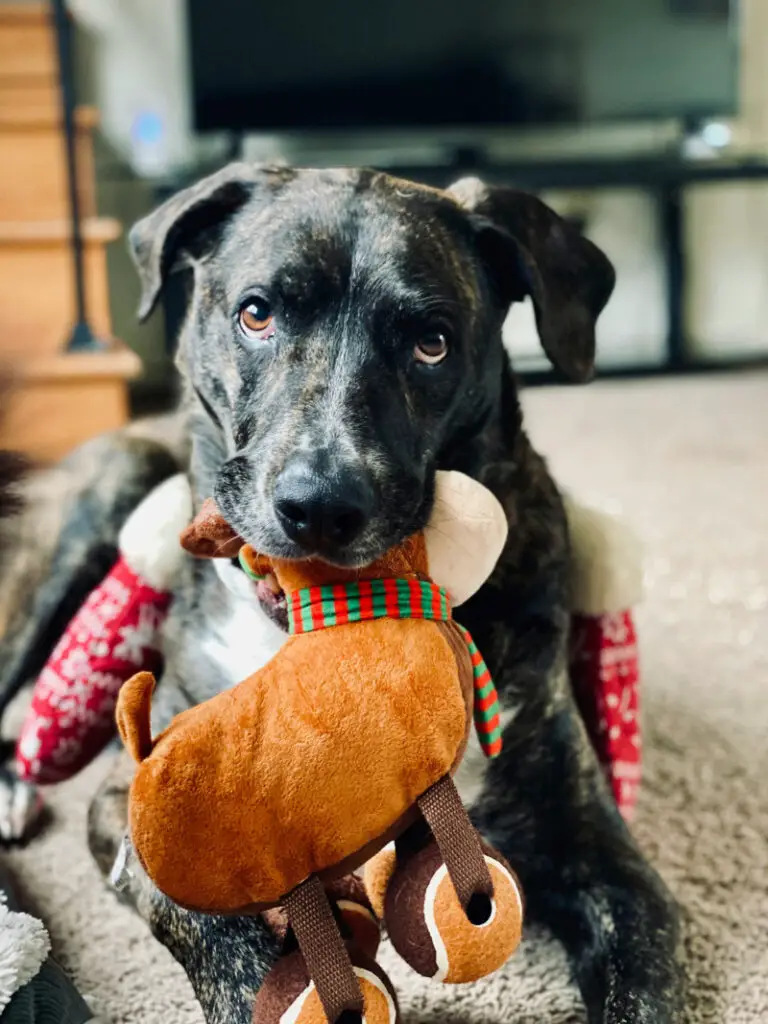Does your dog keep squinting? Have you noticed that his sclera is very red? Are you worried that it is due to a corneal ulcer? Take a look at the following summary and find out everything you need to know about this condition: most common causes, types, symptoms, available treatments, home remedies, useful tips, and frequently asked questions related to corneal ulcers in dogs.
Note: Although different specialized sources in veterinary medicine were consulted during the writing of this article, it should be noted that corneal ulcers are complex conditions that must always be diagnosed, evaluated, and treated by a professional. In case of any suspicion or unusual ocular symptom, please consult the veterinarian.
Table of Contents
Corneal ulcer in dogs: what is it and what are the different types?
The presence of redness, irritation, swelling, or discharge from a dog’s eyes is almost always associated with common problems, such as an infection. However, sometimes these symptoms may be due to a more serious underlying injury or diseases, such as glaucoma, cataracts, or a corneal ulcer.
As its name suggests, the corneal ulcer is a condition that affects the cornea, partly considered the “window of the eye”. In other words, the cornea is the transparent layer that we see on the front surface of the eye, covering the pupil and the iris. This, in turn, is made up of three main layers:
- The epithelium (thin layer of cells on the outer surface of the cornea)
- The stroma (main supportive tissue of the cornea that constitutes 90% of its thickness)
- Descemet’s membrane (the deepest and thinnest layer of the cornea)
Precisely, the corneal ulcer in dogs is an injury or abrasion that occurs on the surface of the cornea as a result of damage or loss of these layers.
Types of corneal ulcer
Not all corneal ulcers are the same. Depending on the layers involved, the following types can be classified :
- Superficial or mild corneal ulcer. It only affects the superficial epithelium. It is a less serious injury and usually heals quickly, but the dog still requires veterinary attention.
- Deep or severe corneal ulcer. The lesion extends through the epithelium and reaches the next layer of the cornea, the stroma. The presence of a deep corneal ulcer usually indicates a bacterial infection; the bacteria release substances that degrade the corneal stroma, causing the ulcer to progress deeply and rapidly. If the ulcer extends to the deepest level of Descemet’s membrane, what is known as a descemetocele occurs. This is considered a serious emergency due to the risk of rupturing the eye. If Descemet’s membrane ruptures, the fluid inside the eye leaks out, leading to irreparable blinding damage to the animal’s eye.
- Indolent corneal ulcer . This type of ulcer, also known as a spontaneous chronic corneal epithelial defect, is of particular concern. It occurs when the epithelium and stroma no longer hold together, probably due to an abnormality in one or more layers of the cornea. This is why indolent corneal ulcers can arise spontaneously, without the presence of an underlying lesion.
Corneal ulcers are particularly common in veterinary medicine, affecting small dogs to a greater extent. Depending on its depth, a corneal ulcer can be dangerous for the pet.
It is a rapidly progressing eye problem that can cause serious damage, including blindness, if not treated early.
What can cause a corneal ulcer in dogs?
In most cases, corneal ulcers in dogs are caused by some type of physical or chemical trauma to the eye, but they can also occur as a result of other scenarios.
In general, these are the 7 most common causes of canine corneal ulcers:
- Blunt or penetrating trauma to the eye.
- Corneal scratches as a result of rough play with other dogs, interaction with cats or sharp objects, and frequent running through woods or thick vegetation.
- Contact with irritating substances.
chemical burns - Underlying diseases, such as the dry eye (decreased tear production leads to drying of the corneal surface) and facial nerve palsy.
- Presence of a foreign body inside the eyelids.
- Infection in the eye (rare cause).
- Accompanying symptoms of corneal ulcer: a painful condition
Typically, the corneal ulcer is a very uncomfortable condition for the dog. It not only causes pain but is often accompanied by a long list of discomforts. Your pet may have the following symptoms:
- Redness and irritation in the white part of the eye
- Excessive discharge or tearing (watery eye)
- Presence of a film over the ulcerated eye
- Light sensitivity
- The dog tries to rub his eyes with his paws
- The dog cannot open his eye or keeps it squinted
Superficial ulcers are not usually visible to the naked eye. In many cases, the veterinarian must resort to the use of a special stain called fluorescein.
Once the dye is placed in the eye, it adheres to the ulcer and produces a green fluorescence, indicating the presence of the corneal ulcer.
What is the treatment for canine corneal ulcers? Medication and Surgery
Many superficial or mild corneal ulcers can heal on their own within 3 to 10 days, depending on the size of the lesion.
This natural healing process is usually accompanied by basic treatment, which includes drops, antibiotic ointments to prevent possible infection, as well as analgesic medications to relieve pain and other discomforts.
It is common for the vet to recommend the use of a collar to protect the eye during the treatment period, as self-injury by the dog can delay and complicate recovery.
In the case of a deep corneal ulcer, the pet will need more aggressive treatment to prevent the ulcer from progressing and increasing in depth. This usually includes the combined use of various drops, as well as the administration of analgesic and anti-inflammatory medications by mouth.
If the dog has a severe corneal ulcer, it will most likely be referred to a veterinary ophthalmologist for surgery. Corneal surgery is usually done with the intention of placing a graft over the ulcer to stabilize the cornea and prevent rupturing of the eye.
In certain cases, the surgical procedure will be focused on removing dead layers of corneal tissue, or those that show little scarring. The veterinarian will know how to determine the best surgery so that your dog can be cured.
Recovery: Follow-up care is crucial
Follow-up care by the veterinarian is essential to determine if your dog has completely healed from the corneal ulcer. As the owner, you should make sure to continue the treatment until the vet tells you otherwise.
Remember that superficial corneal ulcers can heal in 1-2 weeks, but others will take longer to heal.
If your pet’s ulcer doesn’t heal or you don’t see much progress in healing within the estimated time, this could indicate another underlying cause, such as dry eye and trichiasis or misdirected eyelashes. In that case, additional procedures will be needed to facilitate the healing of the corneal ulcer.
In general, it is always recommended to follow the veterinarian’s instructions to the letter and limit the animal’s physical activity during the treatment and recovery period.
You may also be interested in Warts (Papilloma) in Dogs – Causes, Types, and 4 Anti-Wart Remedies
Quick Answers to Frequently Asked Questions
Can corneal ulcers in dogs be prevented?
Considering that corneal ulcers can be due to a wide variety of causes, it is not always possible to prevent them. Even so, there are some useful recommendations that can help you avoid several of the frequent causes, or stop their progress if they exist.
- Do not allow your dog to engage in rough play with other dogs or cats. This could result in scratches and injuries to the inside of the eyes.
- Make sure you don’t have any sharp objects around that could hurt the dog’s cornea by accident.
- Prevent the dog’s eyes from coming into contact with irritating or chemical substances (shampoos, sprays, cleaning products, etc.)
- Check your pet’s eyes frequently for obvious signs of irritation, such as redness or tearing.
- Contact your vet as soon as possible if you notice unusual symptoms in your pets’ eyes.



